NanoVNA
Recently this NanoVNA product popped up on my radar, and like normal, I was a bit behind the group in discovering it. It is relatively newly available, but seems to be rapidly becoming known because it is both inexpensive and very functional. What a wonderful and useful project. There is a group devoted to the project. There is also a secondary product fork recently begun. The second fork will have a larger screen. Software will not be compatible between the two. (update….maybe more than one fork, rapidly changing).
The NanoVNA itself appears to well suited to the home hobbiest, both in price and utility. As an open source hardware design, being produced by various vendors, it is not coming out yet as a mil-spec “ruggedized” product. It is also not $50,000 USD. Also, caveat emptor. The calibration dummy load supplied with the units I obtained measured an intermittent 50K ohms instead of 50 ohms. A second unit supplied a load that measured 43ohms. [I used a known 50 ohm load for the calibrations.]
Dummy loads aside, it appears I wound up with a cheap copy of the cheap copy of the open source hardware. Yet both units appear to function, at least well enough for the 30Mhz of spectrum of interest here at W4KAZ. All images below were captured on a Samsung Galaxy S7, rather than spend a lot of time dorking around with rapidly developing beta software. Truth is – I was in too much a hurry to tinker to take the time for the software, which seems to be FB. Good enough is often “best”. Engineer the Possible. Plenty of time for software later.
Filters Tested
RTL-SDR: The RTL-SDR 2.6Mhz high pass broadcast band filter.  This filter is quite good. Its only drawback is that the cut off is above the 160m band. This helped a lot in testing to find RFI problems, but I needed a filter that allowed 160m. If 160m is not required this is an inexpensive rx only solution.  AE5X also has posted a quickie scan of this filter recently. My own scans…
- RTL-SDR BCB filter, at 3.93Mhz. SWR=2:1, RL=8.63db, IL= 1.4db
- RTL-SDR BCB filter, at 3.93Mhz. SWR=2:1, RL=8.63db, IL= 1.4db
- RTL-SDR BCB filter, at 1.81Mhz. SWR=16.3:1, RL=1.06db, IL= 50.5db
W4KAZ Broadcast Band Filter: While tracking down what I thought were RFI issues on the Red Pitaya CW skimmer, I obtained the RTL BCB filter above. Because its cutoff is at 2.6Mhz I needed something with a lower cutoff frequency.  As a home brew experimental project I came up with a BCB filter, designed using the AADE filter design program, available from KE5FX.   Â
The BCB filter design is shown below, along with the projected rejection. This design is intended to have the cutoff as near to 1 to 1.2Mhz as possible. 680Khz and 850Khz stations are respectively 1.5 and 4 miles from this QTH, and the nearest 680Khz is a 50Kw station. The intent of the design was to null 680 and 850 as much as possible.  This filter also shows a DC short via the 100uh inductor. It can be removed if 60hz mains noise is not an issue.
After construction the filter was originally function tested by checking S-meter levels from the AM band up through HF and a few spectrum glimpses using the Red Pitaya with SDR programs. Using the NanoVNA is a lot quicker. In lieu of computer software for trace captures I just used a field expedient solution – snapping a photo of the teeny NanoVNA screen with my phone.Â
It is nice to see the real world corresponds to theory. The filter shows a 3db shoulder close to design at 1300Mhz. There is a 2:1 SWR shelf across the 160m band. Beyond 2Mhz it rapidly improves. Quite good for my purposes. Also surprisingly good for hand wound coils and ordinary NP0 ceramic caps thrown together without much[i.e., none!] testing of component values. I am not certain if I want to chance tinkering with the tuning of the 680 and 850 notches. Both notches came out about 100 KC lower than designed(not yet shown).
- W4KAZ version of BCB filter. Built using NP0/C0G leaded capacitors, t-80-2 torroids, and a 220uh choke.
- AADE predicted performance plot of the w4kaz BCB filter from DC to 10Mc. Note the nulls on 680 and 850.
- BCB SWR, insertion, and return loss from 50Khz to 3Mhz
- W4KAZ homebrew BCB Filter 50kc to 30M SWR scan
Band Pass Filters:Â
The following set of band pass filters are all constructed based on the K4VX article “Band Pass Filters For HF Transceivers” . A good project, but these were originally only swept for SWR and not a lot of effort to properly tune them previously. NanoVNA to the rescue.Â
10m Bandpass Filter Â
As originally built, 3:1 SWR range is from about 24Mhz to32Mhz. Minimum is at 25.7Mhz, and its usable on the lower end of 10m.
- 10m Bandpass filter scan from 15 to 40Mhz.
- 10m Bandpass filter scan from 20Mhz to 35Mhz.
- 10m Bandpass filter scan from 20Mhz to 35Mhz.
after NanoVNA tuning, a slight improvement across 10m:
- Tuned 10m band pass filter scanned from 15mhz to 40mhz
- Tuned 10m band pass filter scanned from 20mhz to 35mhz, Minimum at 25.400 Mhz
- Tuned 10m band pass filter scanned from 20mhz to 35mhz, on 10m band
15m Bandpass Filter
- Bandpass filter scan for 15M filter
20m Bandpass Filter
- Bandpass filter scan for 20M filter originaly tuned with MFJ analyzer by SWR
- Bandpass filter scan for 20M filter after tuning with NanoVNA
40m Bandpass Filter
Able to tweak the 40m filter from -29.4db to -35.7 db, and filter covers 40m band easily.
- Bandpass filter scan for 40M filter before re-tuning using NanoVNA
- Bandpass filter scan for 40M filter after re-tuning using NanoVNA for a 6-7db return loss improvement
80m Bandpass Filter
????where’d it go?!?!?!?! This one was misplaced somehow……????
160m Bandpass Filter
Very bad news on 160m filter. Looks like a new repair project – not even close to “good enough”!
- Bandpass filter scan for 160M filter – BAD news
- Bandpass filter scan for 160M filter – BAD news
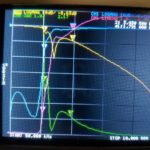
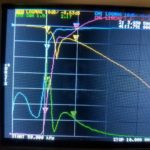
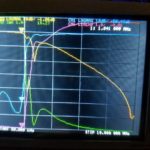
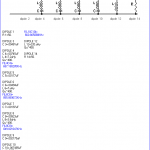
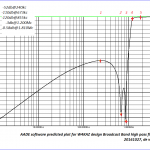
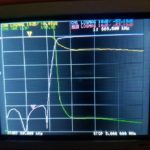
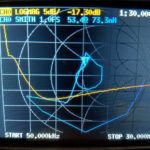
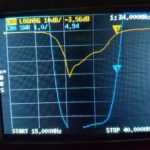
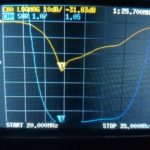
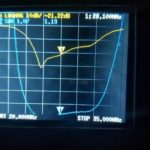
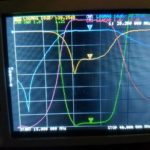
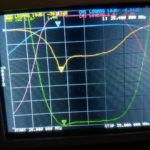
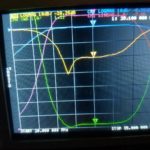
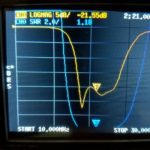
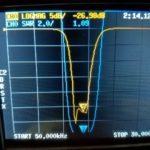
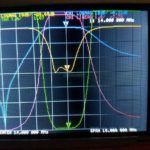
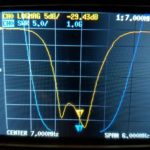
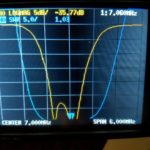
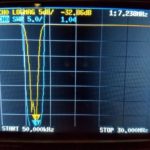
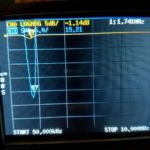
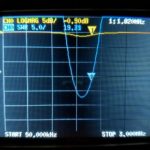
Leave a Reply